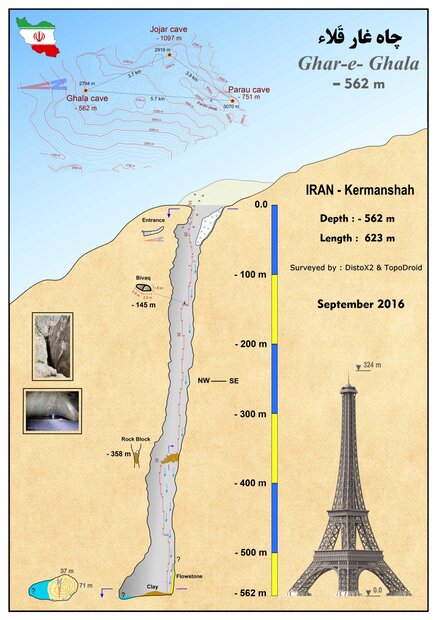A daring journey inside one of deepest caves on Earth

TEHRAN – With a staggering depth of 750 meters Ghar-e Parau, which is situated in western Iran, is one of the deepest known caves in the world. To put that in perspective, imagine almost two Eiffel Tower(s) stacked on top of each other underground!
Situated high in the Zagros Mountain range in Kermanshah province, Ghar-e Parau is possibly the best-known Iranian cave outside the country. It was first discovered and explored by the British Speleological Expedition led by John Middleton in 1971.
The British team consisted of good and experienced cavers and good organizers. In the past, they explored such deep caves as Gouffre Berger and Gouffre Pierre St Martin (France), Antro del Corchia (Italy). At that time they already had the world depth record in mind and, searching various karst areas of the Pyrenees, Italian and Austrian Alps, explored caves in Greece, Yugoslavia, Canadian Rocky Mountains, Mexico, Peru, and Himalaya.
According to Caving in Iran, during that expedition, the British Team descended 22 pitches to reach a depth of –750m with the cave still wide open. The follow-up expedition in the summer of 1972 led by David Judson that was backed by the Royal Geographical Society and the British Cave Research Group sought to extend the cave to a new world depth record.

Despite the best efforts of the 16 strong British Team on that occasion this was not to be the case and Ghar-e Parau continued for another 50m in length to terminate at a muddy sump at a depth of –751m. This event in itself coined a caving term that has stuck ever since. Namely that if a wide-open and promising cave suddenly terminates it is often said to have ‘Paraued’.
In 1975, a Polish team visited the cave, reaching the terminal sump being able to re-confirm that the cave had indeed finished. Over the following year’s team from Iranian Mountaineering and Caving Clubs began visiting the cave, often reaching the terminal sump and often exploring new sections of the passage. A second entrance to Ghar-e Parau has been found, avens in the lower part of the cave have been climbed to try and find a way over the terminal sump and in 2004 a team cavers from the Kermanshah Mountaineering Club put a diver in the sump. On this occasion, the sump was found to descend to a depth of –3m and apparently close. In recent years there have been anything from two to eight or nine trips to Ghar-e Parau each year and using basic SRT techniques many Iranian Teams have reached the bottom of the cave. As a result, some Iranian cavers have got to know the cave very well, with one such example being Yousef Sorninia from the Kermanshah Mountaineering Club who in 2006 claimed to have made 32 trips into Ghar-e Parau, reaching the terminal sump on at least nine of these trips.
In the winter of 2005/2006, Yuri Evdokimov leading a small team of Russian cavers visited Ghar-e Parau and reached a depth of –400m. Realizing the cave and the surrounding area still had good potential, ropes were stored in the cave, and plans were made to return with a bigger expedition in 2006.
Discovery of a fellow cave nearby
In 2014, a team of Iranian cavers led by Sorninia discovered a fellow cave nearby. Sometimes referred to as “the second deepest shaft” in the world, the cave was named Ghar-e-Ghala. It is located in the Parau massif less than 6km north of Ghar-e Parau, and around 100km from the border with Iraq.
The team began exploration in summer 2015. They have described the entrance, at an altitude of 2794m, as being shaped like a “big banana”, with snow and ice found for the first 60m collapsing onto the rock blockage 300m below, where a small hole can be used for shelter or bivouac. For scale, if you look carefully at the photograph of the entrance you can see a caver standing above it on the far side.

Surveying was completed in September 2016, the surveyors are credited as S Mohamadi, M Nejat, H Forozandeh, Y Shariatmadari, and E Mosadegh assisted by S. Lotfizadeh.
The shaft was rigged with 700m of rope and includes three traverses, three deviations, and forty rebelays (a rebelay is created when you attach one rope to two anchors).
A single pitch descent, broken only by a traverse on a blockage at -358m, descends to a large chamber 71m x 37m where there is a sump which has yet to be dived. At 562m Ghar-e-Ghala is just nine metres deeper than the 553m pitch in Patkov Gust, in Croatia.
AFM
Leave a Comment